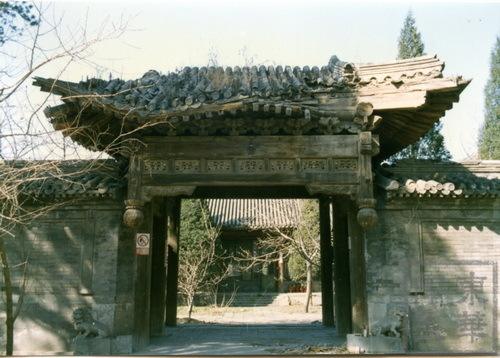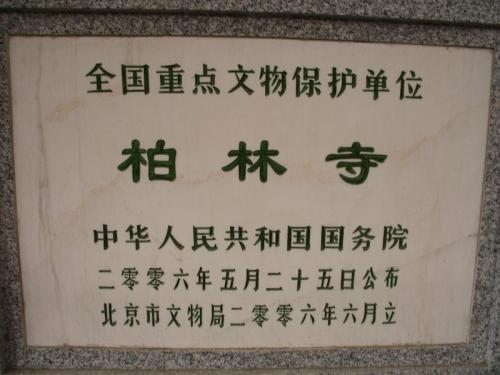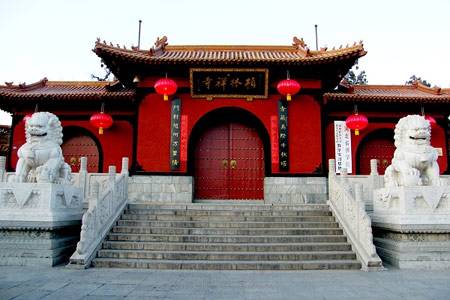24 Hours Hotline: +86 137-3541-1378
Email:beijing@tripstoshanghai.com
24 Hours Hotline: +86 137-3541-1378
Email:beijing@tripstoshanghai.com

Introduction
The Bailin Temple, also known as the "Monastery of the Cypress Grove", is a temple and monastery of Tibetan Buddhism located in Beijing, China. History Imperial era Construction of the Bailin Temple started in 1347, under the reign of Emperor Shun of the Yuan Dynasty, in an open tract of land east of the Temple of Confucius.
History & Background
Imperial era
Construction of the Bailin Temple started in 1347, during the reign of Yuan emperor Shun, in an open tract of land in the capital Dadu, to the east of the Temple of Confucius. The temple, the largest of its kind in Dadu, was occupied by the Sakya school of Tibetan Buddhism, which enjoyed great power under the Mongol emperors. The fortunes of the temple, though, were short-lived: in 1355 the Sakya were overthrown in Tibet by local warlords, and the Yuan Dynasty suffered the same fate 13 years later in 1368, when Dadu was taken by a rebel army and pillaged.
Although the structure of the Bailin Temple mostly survived the event, the monastery fell into disrepair in the following decades. It remained so even after 1421, when the Ming Dynasty moved the capital back to the north, naming it Beijing. In 1447, the Zhengtong Emperor ordered a renovation of the monastery, and in the following years a small square developed in front of the temple’s main gate.
In 1644 Beijing was again taken by a rebel army, and shortly afterwards occupied by the Manchus. Apparently the Bailin Temple did not suffer heavy consequences from the wars. In 1694 a palace for Prince Yong, the fourth son of the Kangxi Emperor, was built directly west of the temple. The prestige of this new neighbour resulted in the gift of a monumental bell in 1707, and in a complete renovation of the monastery in 1713 on the occasion of the 60th birthday of the Kangxi Emperor. The works of renovation were directly supervised by Prince Yong himself who, in 1722, succeeded to the throne as the Yongzheng Emperor. That same year, the new monarch donated part of his former palace to Tibetan lamas of the Gelug school, which would transform it, in a few decades, into the largest Tibetan temple outside Tibet, the Yonghegong Lamasery (???).
The rise of such monastery resulted in a partial oblivion for Bailin Temple which, by the end of the dynasty, had become dependent on its western counterpart. However, the generosity of the Qing emperors and the wealth of the Gelug school made sure that temple was kept in good repair. In 1758, the Qianlong Emperor ordered a lavish renovation of the buildings, part of his great project to shape Beijing into a monument to his power.
Like the Yonghegong Lamasery, Bailin Temple was not touched during the pillages of 1860 by Anglo-French forces and of 1900 by the Eight-Nation Alliance, because of the superstitious fear that Tibetan Buddhism inspired to the invaders.
Modern era
The phenomenon of decadence aggravated after the Communist takeover of Beijing in 1949. In August 1966, the temples were attacked by Red Guards, who evacuated the lamas from the area and reorganised the buildings, including dormitories, stables, warehouses and shrines outside the main temples, assigning them to danwei. After this period several brick structures were built inside Bailin Temple’s walls and the screenwall was linked to the main walls to create a closed courtyard; the Drum and Bell Towers were torn down, and the stone lions, the Buddhist statues and two stone tablets displaying the rules to observe inside the temple disappeared. After the Tangshan earthquake (1976), the flow of refugees dramatically increased density in and around the temple.
In 1988 Bailin Temple was designated by the government to host the Cadre Academy of the Ministry of Culture/Central Academy of Cultural Administration (???????) and the Beijing Historical Site Preservation Bureau, in addition to other private and public companies’ offices. In 1992 the government funded a renovation of the temple, which restored the original building but did not touch the new ones. Since 2007, the Beijing Cultural Heritage Protection Centre (CHP) also established its headquarters in one of the buildings. In Autumn of the same year, a public mill (a stone slab used by the community in ancient times to grind cereals) in front of the temple has been destroyed, as the road was levelled for easier traffic.
Architecture and artwork
The five main structures in the temple compound are laid out on a central axis. Proceeding from the front gate to the rear of the temple, they are as follows: the main gate, the Devaraja Hall (Hall of the Heavenly Kings), the Hall of Attaining Perfection (Yuanjuxingjuedian), the Mahavira Hall (Daxiongbaodian) and the Vimalakirti Hall or Hall of Bodhisattva Purity (Weimoge).
A horizontally inscribed plaque in the handwriting of the Kangxi Emperor which reads "The Everlasting Cypress Grove" (Wangubailin) hangs on the fa?ade of the Mahavira Hall, while statues of the Buddhas of the Three Worlds are found inside. Behind this hall is the Hall of Vimalakirti, containing seven carved and gilded Buddha images dating from the Ming Dynasty.
To the east of the main hall is an auxiliary hall containing two large bronze bells 2.6 metes tall cast in 1707. Their surfaces were cast with bas-reliefs of coiling dragons and a mantra to be intoned after a person's death in the hope of gaining passage to the Pure Land.
Among the valuable relics in the temple are a complete set of printing blocks for the Tripitaka carved in the early 18th century. The collection has 7,240 volumes with a total of 78,230 separate blocks. Carved of high-grade pear wood, the blocks remain in fine condition today except for some minor cracks. The work of carving took six years to complete and was begun in 1733 during the reign of the Yongzheng Emperor. However, fewer than 200 copies of the Tripitaka were printed during the ensuing 300 years, one reason why the blocks remain in excellent condition.
The blocks were originally stored in the Hall of Military Eminence (Wuyingdian) in the Palace Museum, but were later transferred back to the temple. They are presently being cared for under the supervision of the Beijing Library.




Information
The Bailin Temple is located in Dongcheng District, Beijing. The postal address is: 1 Xilou Hutong, Beixinqiao, Dongcheng District, Beijing
Duration:7-8 Hours
Attractions(Cities):Tiananmen Square, Forbidden City, Temple of Heaven, Summer Palace
Tour Style:Experience Beijing like never before with our meticulously crafted Beijing tours. Immerse yourself in the rich history and vibrant culture as you visit iconic landmarks such as Tiananmen Square, the grand Forbidden City, the serene Temple of Heaven, and the majestic Summer Palace. Each tour offers in-depth insights and captivating stories, guided by experts who bring the city’s past and present to life. Enjoy personalized attention and comfort as you explore Beijing’s timeless treasures, including exclusive access to hidden gems and local favorites. With our Beijing tours, every moment of your journey is designed to be both educational and enchanting, ensuring a truly unforgettable experience.
Duration:2 Days, 1 Night
Attractions(Cities):Temple of Heaven, Tiananmen Square, Forbidden City, Nanluoguxiang, Mutianyu Great Wall, Summer Palace
Tour Style:Embark on a fascinating 2-day adventure in Beijing, where you’ll delve into the city’s storied past and vibrant present. Start with the majestic Temple of Heaven and the iconic Tiananmen Square, then uncover the grandeur of the Forbidden City, a treasure trove of imperial history. Stroll through the charming Nanluoguxiang, where traditional architecture meets modern vibrancy. Experience breathtaking views from the Mutianyu Great Wall, a marvel of ancient engineering, and unwind amidst the serene beauty of the Summer Palace’s lush gardens and elegant pavilions. This thoughtfully crafted tour offers a perfect blend of historical insights and cultural experiences, designed to captivate your senses and spark your curiosity.
Duration:3 Days, 2 Nights
Attractions(Cities):Tiananmen Square, Forbidden City, Temple of Heaven, Jingshan Park, Summer Palace, Kunming Lake Boat Riding, Nanluoguxiang, Panjiayuan Antique Market, Mutianyu Great Wall, Bird's Nest, Water Cube
Tour Style:Immerse yourself in Beijing's rich history and vibrant culture with our exclusive 3-day private tour. Begin with the grand Tiananmen Square and the majestic Forbidden City, then visit the serene Temple of Heaven. Enjoy stunning sunset views from Jingshan Park and a scenic boat ride on Kunming Lake at the Summer Palace. Wander through the lively Nanluoguxiang Hutong, hike the breathtaking Mutianyu Great Wall, and marvel at the modern Bird’s Nest and Water Cube. This personalized tour offers a perfect blend of historical splendor, cultural immersion, and architectural wonders, ensuring a truly unforgettable experience. Every moment is designed to captivate and inspire, leaving you with lasting memories of Beijing's diverse allure.
Duration:5 Days, 4 Nights
Attractions(Cities):Mutianyu Great Wall, Bird's Nest, Water Cube, Qianmen Street, Morning Market, Forbidden City, Tiananmen Square, Jingshan Park, Temple of Heaven, Nanluoguxiang, Facial Makeup Painting, 798 Art Zone
Tour Style:Immerse yourself in Beijing’s rich culture and history with our comprehensive Beijing tour package. This meticulously crafted Beijing trip takes you through iconic landmarks including the Mutianyu Great Wall, Forbidden City, and Tiananmen Square, alongside modern marvels like the Bird's Nest and Water Cube. Delve into local life at Qianmen Street and the Morning Market, explore artistic expressions in the 798 Art Zone, and enjoy hands-on activities like facial makeup painting. With expert insights from a seasoned Beijing travel guide, this tour offers a seamless blend of historical exploration and cultural immersion, ensuring a memorable Beijing experience.
Duration:10+ Hours
Attractions(Cities):Terracotta Warriors Museum
Tour Style:Embark on a captivating day trip from Beijing to Xi'an to explore the iconic Terracotta Warriors. This Beijing-Xi'an tour offers a deep dive into ancient Chinese history, featuring the world-renowned Terracotta Army, a monumental archaeological site showcasing thousands of life-sized soldiers, horses, and chariots. Enjoy seamless travel with our expert guide providing insightful commentary on the historical significance and intricate details of these remarkable figures. This day trip promises an enriching cultural experience, combining expert-led exploration with smooth logistics for a memorable journey from Beijing to the Terracotta Warriors.
Wechat: Chinaprivatetour
24 Hours Hotline:
+86 137-3541-1378
(Your Privacy is Protected)
1 to 1 tailor-made service from our professional travel advisors for the most sophisticated
Constantly excellent reviews for attraction, hotel and service Competitive price
Local experts provide quality tours Best selected knowledgeable local guides Authentic local restaurants
7*24 hours available to create you a worry-free tour. No Hidden Fees and absolutely no pressure to buy. Secured









Copyright © 2017 Chinabeijingprivatetour.com All rights reserved. 浙ICP备18056007号-2